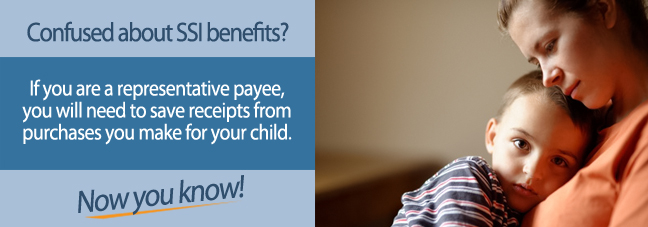If your child suffers a disability, he or she could be eligible for SSI benefits. SSI, or Supplemental Security Income, is a Social Security program that is based on a family’s means and is meant to help low-income families with medical costs and living expenses.
If your child qualifies for SSI benefits, there are a few things you need to know about how those benefits will be received.
Finding a Representative Payee
If your child is disabled and under the age of 18, the Social Security administration will determine a representative payee, who is typically a parent. If you are your child’s representative payee, this simply means that you will be managing the SSI payments sent to your child.
Parents sometimes make the best representative payee because they will likely know their child’s needs best. The SSI benefits are intended to go towards the disabled child’s basic needs, such as food, clothing, and medical care. After paying for the child’s needs, if any money is left over, the representative payee must put the rest of the funds into an interest-bearing savings account for the child’s future needs.
How You Can Spend These Funds
There are several rules and regulations the representative payee must adhere to in order to prevent misuse or abuse of these funds.
If your child receives a large lump-sum in retroactive payments covering more than 6 months, you will need to create a separate interest-bearing bank account specifically for these funds. This will be called a dedicated account, and it won’t be counted by the Social Security administration as SSI income. However, this money must only be spent on special expenses.
You can spend money from the dedicated account on medical treatment, education, and job training. You can also use it to pay for anything related to the child’s disability such as therapy or special equipment. If you use the dedicated account money to pay for something other than the allowable expenses, you will have to pay that money back to the Social Security administration.
As representative payee, you have a responsibility to use your child’s benefits to cover your child’s needs, and Social Security requires that you account for your spending by sending a Representative Payee Report once a year. The Representative Payee Report is how SSI benefits are reported. To easily file this report it is very important to have clear records of all spending from this account, including receipts. You must also account for all the money that you may have saved.
The Social Security Administration needs to know that you are spending these funds in the manner which they were intended, which is to meet your disabled child’s needs. It is very important to keep a record of all benefits received, and all spending and saving of those benefits.
Because SSI is a needs-based program, you will also be required to send proof that you are still within the program’s rules for qualifying, and it is crucial to report any changes to your income or the beneficiary’s income that might affect their eligibility for SSI payments. The disabled child’s monthly wages must be reported if he or she earns an income, and the parent’s monthly wages must be reported as well. The Social Security Administration needs to see every pay stub for you and your child.
Getting the Help You Need
It can be extremely helpful to contact a disability attorney to help navigate the special rules and requirements related to applying for and receiving SSI payments.
